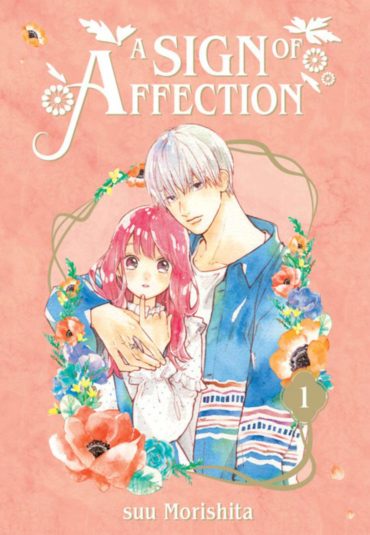A Sign of Affection Volume 1
Yuki is a college student who loves fashion and hanging out with her best friend Rin, but she’s never been in love before. Enter Itsuomi, a tall, silver-haired, handsome man who helps Yuki on the train when she’s unable to communicate with a tourist. The good news is that Itsuomi can speak three languages, the bad news is that Yuki is completely deaf and can only communicate via sign language or texts. The unlikely pair are drawn to each other regardless, but can love bloom despite the language barrier?
The author, Suu Morishita, is actually two manga creators, who split the duties (such as storyboarding and artwork) between them, but for this manga there’s also co-collaborator Yuki Miyazaki, who oversaw the use of sign language for this story. Both at the top of the book, and in the interview provided at the end, the manga co-creators wanted sign language to be at the forefront of the story, as having deaf characters (let alone protagonists) is rare in shojo manga. Regardless of how passionate you are, or how pure the intentions are, it’s important to not only listen to the experiences from the minority you wish to write about, but also to be sensitive and empathetic, not condescending, when portraying them. Luckily, just from the first volume, it’s clear to see not only how much passion the authors have for this story but also the research they went into to bring Yuki’s world to life, despite her not being able to speak.
The story is 90% told from Yuki’s perspective, with the last 10% being a couple of panels switching to another’s point of view just to flesh out the story, but not enough to completely take over Yuki’s narrative. It’s important to make that distinction because she is deaf, and so you’ll notice very early on that panels of her in the streets, trains, malls – places that normally have lots of noise – are lacking sound effects. We only get a few across the story, but they’re either not from her point of view, or are clearly in her field of vision so could be potentially caught by her hearing aid. It’s a clever little detail that an average reader would have probably not picked up on if the mangaka had just kept them as per usual, but the fact that they’re carefully placed makes Yuki’s unique point of view all the more real and authentic. Yuki is also a lip reader, and how they portray this is very clever: when a character is talking, and Yuki’s reading their lips, the text is slightly faded, but the moment it’s out of Yuki’s field of vision, it’s bold, so the audience doesn’t miss any of the story detail, even if Yuki does. As for portraying sign language itself, the mangaka themselves admit that showing the full works in manga is difficult to do, and says that for some sentences they have to only show parts, but we do get enough to distinguish important words and story beats when Yuki meets with a friend who also uses sign, and at one loving moment in the climax of the book.
Speaking of romance, the pair look cute together, but are they meant to be? Like any new relationship, they act both sweet and awkward around each other, with the language barrier being both a hindrance but also a motivation to try and get to know one another. Itsuomi is clearly out of his depth, as he’s used to speaking with people from many different countries, and breezing into their cultural language, but as his love interest is one who cannot speak, his awkward attempts to make eye contact with her at all times is both weird and sweet. He gets an ‘A’ for effort, anyway. As for Yuki, it’s mentioned halfway through the book that college is her first experience with multiple people and larger classrooms, so her lack of social skills makes sense. Living with her disability also adds to her level of discomfort with ordinary things that most of us take for granted, like meeting new people or suddenly someone touching her that she can’t see or hear right away. It’s easy to see why she’s so fascinated with Itsuomi, as he makes an effort to communicate with her not just by learning sign but also looking her at directly at all times. The pair have an instant chemistry that you want to see unfold with every page turn.
Art for A Sign of Affection is stunning; the cover itself perfectly demonstrates the beauty of it from the shading to the details in the faces and hands (both super important in communication) and shows how physically the pair differ, but also look super cute together. The book has a lot of close-ups of faces, and despite Itsuomi being rather stoic, the art perfectly captures the gentleness of his personality and how, like Yuki, is also rather overwhelmed with the new emotions he’s experiencing even if he’s not so sure how to communicate them.
The translator for this book is Christine Dashiell, who’s translated tons of manga as well as staffed in many anime translations from Marmalade Boy to The Melancholy of Haruhi Suzumiya. She provides a really good translation, not only with handy notes at the end but also bringing Itsuomi’s jumps from one language to another to life perfectly as well, and Yuki’s inner voice is very distinct as well. The book also contains an interview from the authors, the same one that’s available on Kodansha’s website.
Fans of A Silent Voice, or anyone who wants a new, cute romance manga to fall in love with, look no further than this. It’s a beautifully drawn and written love story that will melt your heart, like the snow in the protagonist’s name.


